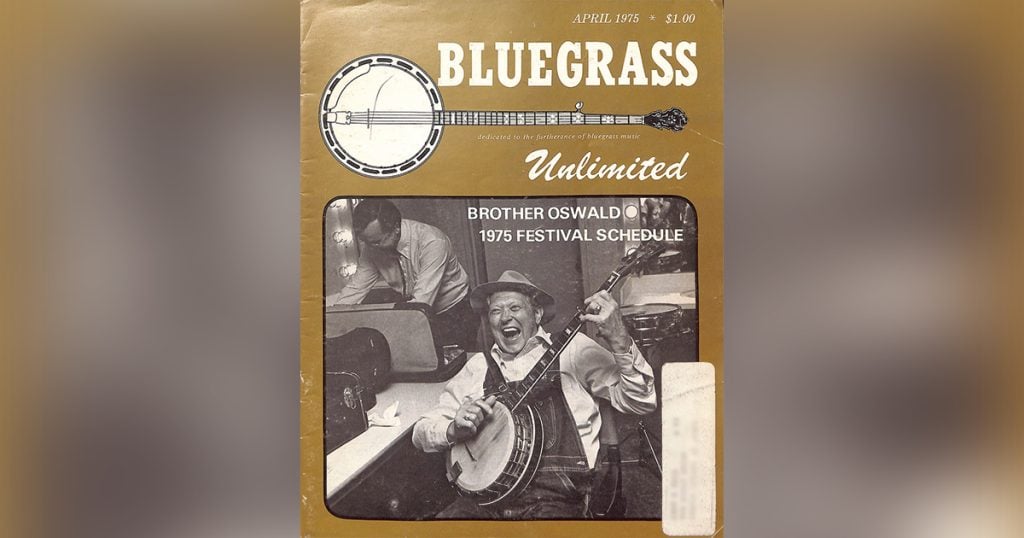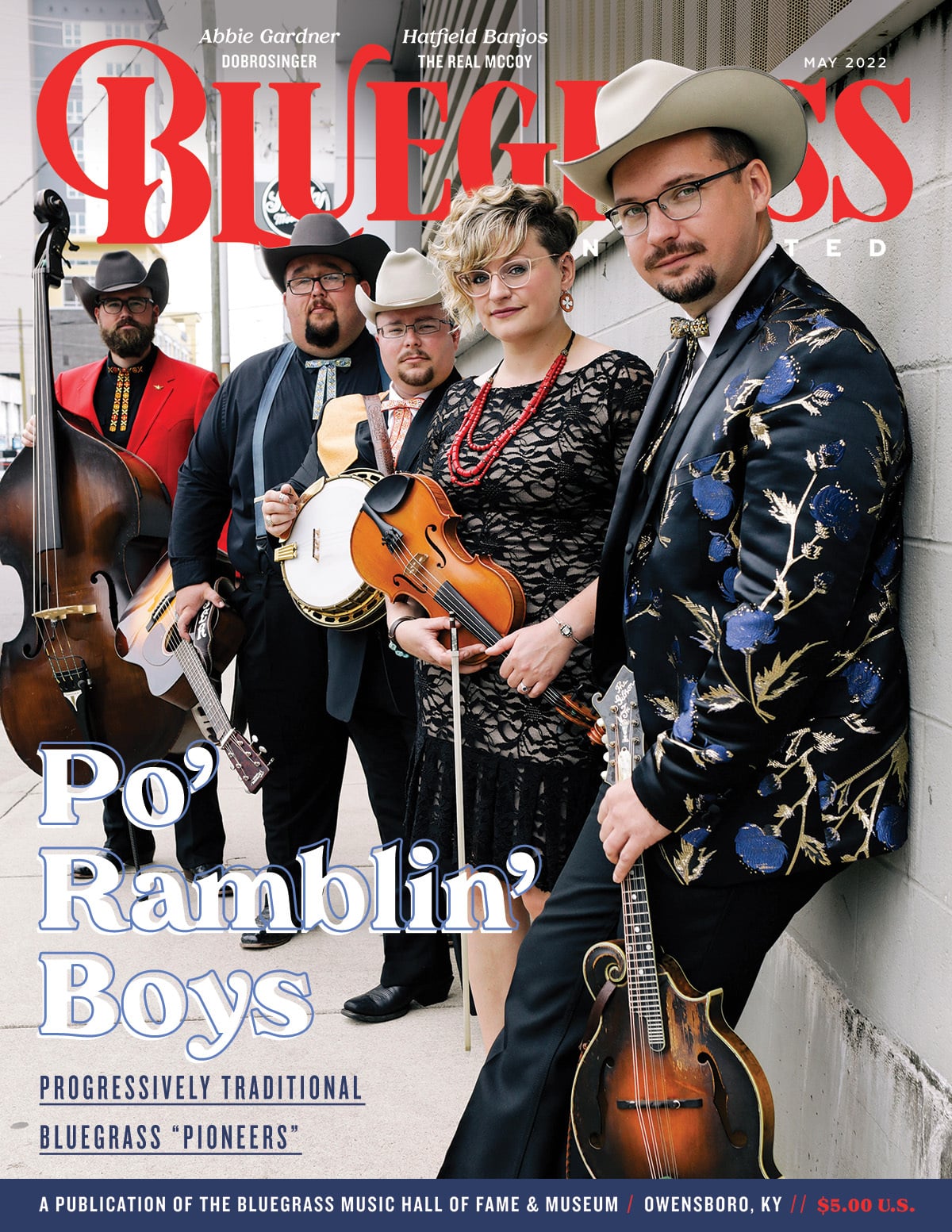Home > Articles > The Archives > Brother Oswald: That Good Old Mountain Music
Brother Oswald: That Good Old Mountain Music
Reprinted from Bluegrass Unlimited Magazine
April 1975, Volume 9, Number 10
Introduction:
B.R. “Pete” Kirby, better known by millions as Bashful Brother Oswald of Roy Acuffs Smoky Mountain Boys, is truly a remarkable performer. Oswald was one of the first to develop the Dobro sound, and during the thirty-eight years he has been with Roy Acuff and on the Grand Ole Opry, many have been influenced by his style. Probably no one else has contributed so much to the present popularity of old-time Dobro music. Oswald has also contributed greatly to comedy in country music acts. In addition, he has a strong tenor voice and plays banjo, trailing style, making him a well-rounded musician.
“I love mountain music,
Good old mountain music,
Played by a real hillbilly band.”
As Brother Oswald sings this tune on his latest album with Charlie Collins, That’s Country, you know that his love for old-time mountain music is real. He was born up in the Smoky Mountains about 10 miles from Sevierville, Tennessee to G.W. and Barbara Kirby the day after Christmas, 1911. Never being fond of his given name, he started going by Pete when he left home. His real name, to this day, is one of his best kept secrets!
At a very early age Brother Oswald had exposure to the music of his native Smoky Mountains. “I just grew up hearing music. We didn’t have a radio. I never even saw one before I left home. I just learned to play from listening to the people around me. Our family was the main ones in them mountains who could play music, and every Saturday night, it didn’t matter if there was snow knee-deep, the neighbors from all around was at our house to hear us play.”
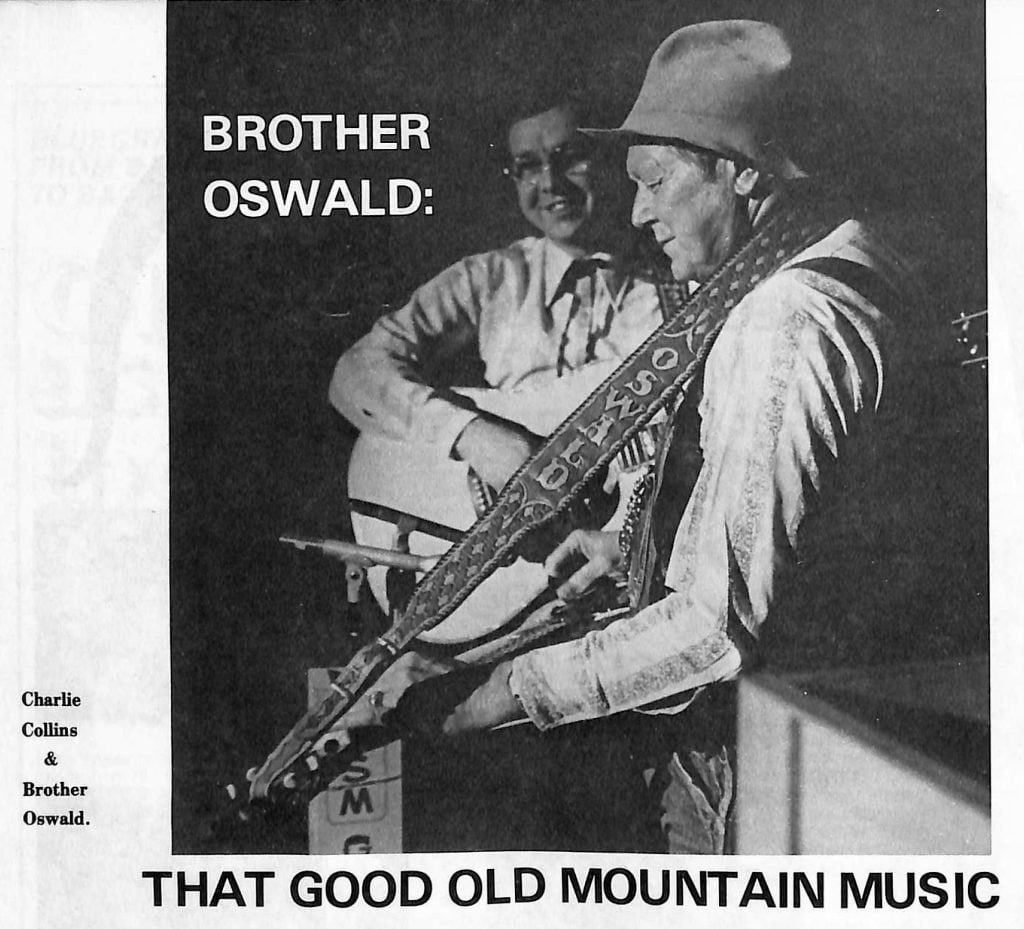
By the age of five, Brother Oswald was playing the guitar and banjo. Although he is known most for his Dobro playing, he was in his late teens before being introduced to that instrument and style of playing. His Dad played the guitar, fiddle and banjo, and most of his brothers and sisters played at least one instrument. “Some of the neighbors could play, and they would join in. Our house was the headquarters for all the music up in that country. Often we’d have bean hullings. We would spread a big sheet out on the floor, and everybody would sit around shelling beans until they hulled them all up, and we’d play while they were hulling. And my mother would be a’coolin’. She would have two big kettles hanging down from the fireplace, one full of chicken and dumplings and the other full of beans. It seemed there were people at our house all the time.”
G.W. Kirby worked in a barber shop in Sevierville, and was only able to come home on week-ends. Feeding a family of 10 children wasn’t easy, and by the age of thirteen Oswald started working in a saw mill, stacking lumber. “I could either stay at home and make a dollar a day, or I could stay up at the camp at the saw mill for seventy-five cents a day. I walked it many a day just to make that dollar! It was about three miles from my house, right straight up the mountain.”
Later Oswald quit the saw mill and went to Knoxville where he got a job in a cotton mill. While in his late teens, an uncle who was a foreman at Buick Motor Company came down for a visit and suggested that he might be able to get him a job in Flint, Michigan. “I got to thinking it over, and I decided that I’d just catch the bus and go up there. I took a guitar along, a little old Regal guitar with a pearl neck on it. Boy, I thought that was really something! But when I got up to Michigan, I never could get a job. There was a big strike comin’ on and I never could get in the factory, so I just stayed around there and played music, mostly for house parties.”
Shortly after his move, Oswald got his first introduction to Hawaiian style guitar playing which was to greatly influence his style of Dobro. “There Clarence Clark had a studio where they taught music. There were four boys teaching there. I found out about it and I’d go down there to visit them nearly every day. This Hawaiian, Rudy Waikiki, would come in there too, not to teach; he’d just sit down and pick. He’d play this old wood guitar on his lap, pickin’ with three fingers, rollin’ style, and fretting with a steel bar. I’d go home and try to imitate him by putting a bar under my old guitar and foolin’ with it. But I never took it serious or played it for an audience back then. That was in 1929. I had never seen or heard that type of pickin’ before then.”
It was nearly two years later before Oswald was to begin his distinguished career playing the Dobro. In the meantime he had gone back home to Tennessee, then was lured back north to Chicago at the time of the World’s Fair, with the added job opportunities. He got a job in a restaurant and worked at the World’s Fair both years. But it was his ‘moonlighting’ that he enjoyed most. In the evenings, he and other musicians would play at bars, clubs, burlesque shows, hotel lounges; just wherever they could find an audience. At first he mostly played the banjo, frailing style. Someone else would play guitar and sometimes they would have a fiddle player.
Oswald recalls his first appearance as a Dobro guitar player: “One night the man that owned the club where we was playin’ told us we’d just have to get one of those Hawaiian guitar players. Across the street they had one playin’ and taking all of our business away. And I told him, ‘Well, you’ll have one tomorrow night!’ So I went out and bought me a guitar, an old National, one of them shiny ones, and I played it the very next night. At first I just played softly in the background until I learned a few tunes. Then I started taking breaks in the numbers, remembering how the Hawaiian in Michigan had played. I just seemed to fall into it naturally right away.”
It seems incredible that although two years had elapsed since Oswald had last heard the Hawaiian play in Michigan, he could recall perfectly perhaps two dozen of the Hawaiian songs he had heard played, and now, forty-five years later, these still are some of the favorites in his repertoire. Rudy Waikiki can be given the most credit for contributing to Oswald’s style. From him Oswald learned marches such as “Hilo March” and “Island March” and many of the slow, dreamy tunes, such as “Song of the Islands.”
“When the fair was over, me and a boy that had been working on a radio station in Gary, Indiana hitch-hiked to St. Louis, Missouri to see Skeets Yaney. He was a fine yodeler back in those days. We went all that way, and then didn’t have a nickel each that it cost to walk across the bridge. So we waited until night, played in a beer joint and passed our hats and got some nickels to cross the bridge the next morning. And wouldn’t you know it, Skeets was out on the road! So we had to play in a bar over there that night to get some nickels to get back across the river. Then we hitch-hiked back to Champaign, Illinois where my friend was from.”
In Champaign, a letter was waiting from Oswald’s brother saying to come home. Returning to Knoxville, Oswald soon met his future wife, Lola, and in 1936 they were married. The responsibilities of married life precluded more wanderings as a musician, so he found work in a local bakery. However, his love for music led him to meet and pick with musicians in the Knoxville area.
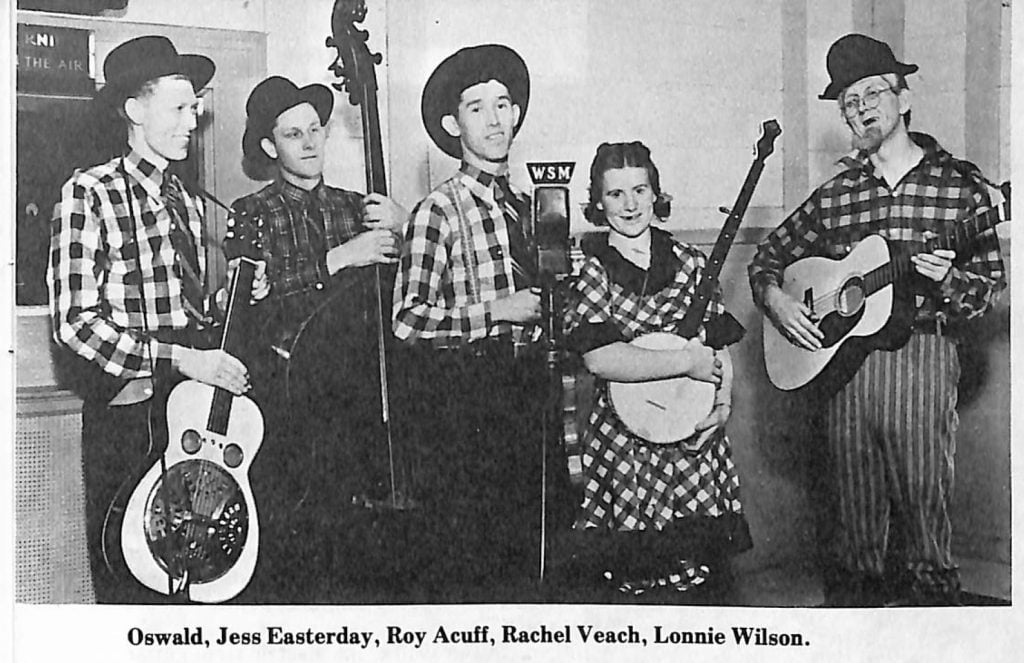
“Along in there is when I first met Roy Acuff. He had the Mid-day Merry-go-round show there in Knoxville on station WNOX. Later he left and went to WROL and started his own show there. I wasn’t a regular with him back then. I’d just stop by to pick, and then I’d go out on the road with him if some of his boys couldn’t go. I played a dance with him one night, playing the Dobro, and then he said if he needed me, he’d holler. And it wasn’t but about three weeks until he was hollerin’.”
About that same time Roy Acuff had joined the Grand Ole Opry. He had gone down for an audition; then one day got a call saying that Arthur Smith and Sam and Kirk McGee were off that Saturday night and to get his band over to Nashville to take their place. It wasn’t more than a couple weeks later that he was asked to take a regular job on the Opry.
“Clell Summey, ‘Cousin Jody’ they called him, was playin’ the Dobro for Roy when they started on the Opry. It was maybe two or three months. Then Red Jones and Cousin Jody was fixin’ to leave Roy and he found out about it and came up to Knoxville and asked me and Lonnie Wilson to join him.”
In addition to Clell Summey playing the Dobro on the Grand Ole Opry, Sam McGee played an old National guitar for a short time. And there may have been others. However, the Dobro sound never became popular until the audiences heard Oswald play it with his special style, touch and control. He did a lot more back-up and breaks than had previously been done, and the people started noticing. Roy Acuff’s hit songs of this era, “The Great Speckled Bird”, “Wabash Cannonball”, “Carry Me Back to the Mountains” and others, all featured the Dobro as the most prominent instrumental sound. Many people, having never seen the Smoky Mountain Boys in person, believed that Roy was playing the Dobro. Two of the best-known steel guitar players, Shot Jackson and Little Roy Wiggins, learned to play by listening to Oswald on the Grand Ole Opry, thinking it was Roy playing. Little Roy Wiggins later further studied Oswald’s style in Nashville, and of all the steel guitar players, his style most resembles Oswald’s.
“People was always cornin’ to me through the years wanting to learn to play. The Dobro intrigued them. I could have probably made more money teaching, but I don’t know how to teach. When you’re playin’ by ear, you don’t play the same way all the time, and you have to play the same way all the time if you’re going to teach anybody. You have to have a method to go by. I don’t have a method, I just have to play what I feel.”
For Oswald to play what he feels isn’t bad! In addition to all the unique breaks and special treatment he gives songs with his style, he is also the author of several Dobro instrumentals, including “Sailing Along” and “Dobro Chimes”.
The Dopera Brothers had started making the Dobro instrument in the mid 1920’s, but it wasn’t until 1928 that they formed a company and got their instruments patented. “The Dobro I used to play back when I started with Roy was a 1929 model. It was a big thrill to join Roy’s band and come over to the Grand Ole Opry. When I first come down here, the Opry was held over on Fatherland Street. That building had a dirt floor, and the seats were just concrete blocks with a plank laid over them. That building held maybe three-hundred people, maybe not that many. Not as many performers were on back then, not as many sponsors either. But Stevens work clothes was already a sponsor then. Another I remember was called Red Top Fence, a fencing company.” From Fatherland Street the Opry moved to the fifth floor of the National Life Building, then over to War Memorial Auditorium, and then down to the Ryman.
Tent shows were very popular in the late 1930’s, and Roy Acuff and his Smoky Mountain Boys would be out working the tent shows between their weekend Opry performances. “In the beginning, before Roy was big, we’d take other performers with us to help build a crowd. He’d take along Deford Bailey, that little colored harmonica player and Robert Lun, Uncle Dave Macon and the Delmore Brothers. Later we didn’t need anyone else to travel with us. Just our band could put on a whole show with real variety. We’d change clothes and do different things. Like we had a jug band for years.”
“There was some comedy, but not much, on the Opry before Roy come down here. Roy’s show always had comedy. When I joined him, there was also another boy that came, Jake Tindle. He came as a black-faced comedian. Then Lonnie Wilson would dress as an old man with whiskers and everything. We called him ‘Pap’. And I just dressed straight until Rachel came along.”
Roy Acuff brought a girl into his show around 1940. Rachel Veach was a real fine country girl, but the mail started coming in bad, saying Roy’s image would be ruined with a girl traveling with all those men. “Rachel was probably with us a few months when Roy hit upon this idea. We’d be ridin’ along in the car between shows and be talkin’, and I’d do that laugh of mine, ‘Ye-e-e-e-e’ Roy would think it was funny, and he said, ‘I’ve got an idea; from now on, you’ll be Rachel’s big Bashful Brother Oswald.’ We went up in North Carolina and we was playin’ the court house up there at Robbins. Roy had gone out and got me some outfit to wear. We walked out on stage, Rachel followin’ behind me, and we just were lookin’ at each other and laughin’. Never said a word or played a tune or nothin’. The people just died laughing at us!”
From then on Oswald and Rachel had a regular part on Roy’s show. Oswald would dress straight to start the show, then along in the middle, he’d change and he and Rachel would come out like a new act. Rachel would play several tunes on the banjo and Oswald on the guitar; then they would switch instruments. Once Rachel had a ‘Bashful Brother Oswald’, there was never another letter of complaint, in spite of the fact that his name was Kirby and her name was Veach.
Later on Oswald added a black wig to his costume. Then came the costume that he is still wearing today. “I’ll tell you how it came about, what started the whole thing. Roy had a bunch of Tennessee Walking horses out on his farm, and a magazine came out to make a picture of one of the horses named Pearl Harbor. The horse wouldn’t stand still for nobody. I was plowin’ out there in the field with a bunch of horses when I seen that they were having trouble. So I went over and jumped up on him. He was used to me being around him, and he just stood perfect and they shot the pictures. From then on Roy said that’s the way he wanted me to dress, with them bib overalls and hat, because I had gotten the horse’s attention so well and the picture was seen by so many people in that magazine.”
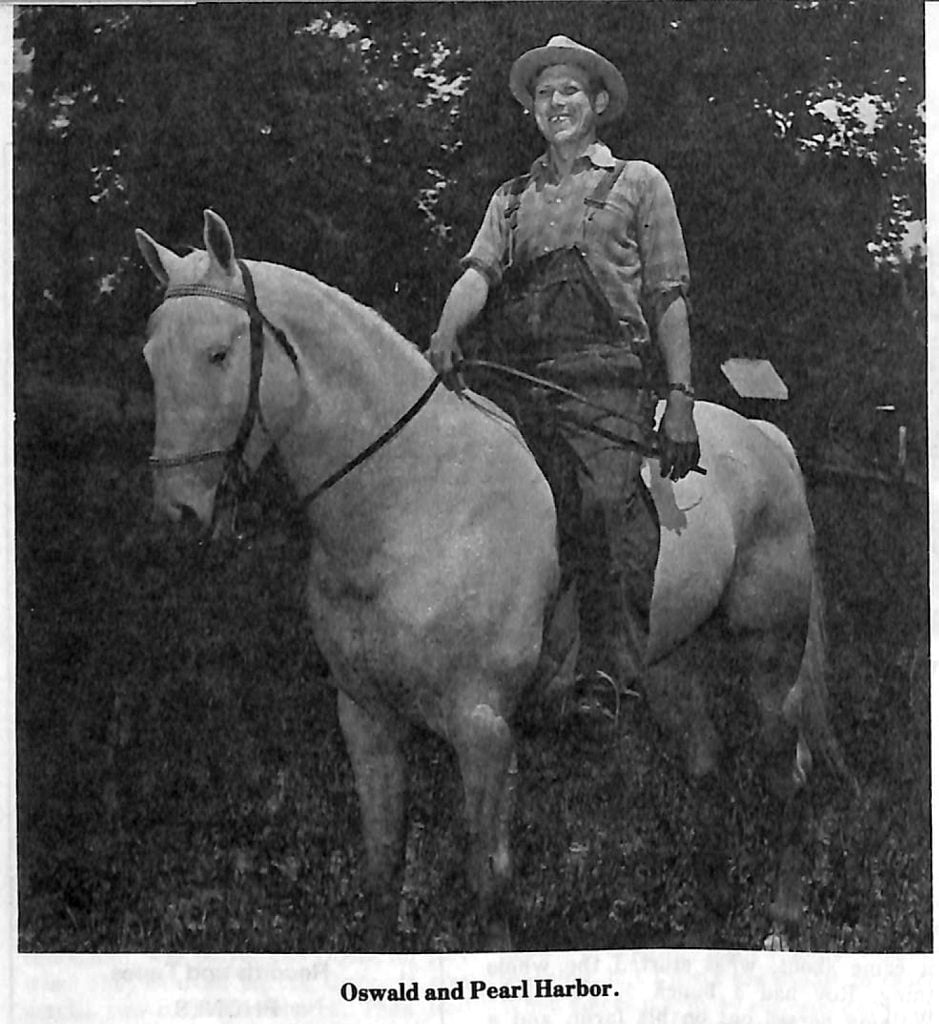
Everyone in Roy’s band had some comedy back in the 1940’s, with Roy being the only ‘straight’ one. They would do anything for a laugh, even fall off the stage if they had to! An example of some dialogue: Oswald: Whiskey and women killed my daddy.” Roy: “How’s that?” Oswald: “He couldn’t get either one so he just laid down and died! Ye-e-e-e!”
Other gimmicks have been used by Oswald through the years to get a laugh. One of his favorites is his oversizes shoes, size 44 to be exact! “I saw this display in the window at Jarman Shoe Company and I asked them if I could have them shoes when the display was done. They were happy to give them to me, especially with “Jarman” painted big on the bottoms. So I had some regular size shoes built into them. I’d come clomping out on stage with those things on and the people would die laughing. I still wear them quite often yet today.”
In the early 1940’s Roy Acuff and the Smoky Mountain Boys went to Hollywood. Roy starred in 10 movies for Columbia and Republic pictures. The whole band was there, but Oswald and Lonnie Wilson were the only ones who got to do much acting with Roy.
“When we were making a film out in California, we would have to do our whole Opry show live over the telephone. I would do my jokes right over the telephone, taking back and forth with Judge Hay on the Opry stage. We did our commercials over the phone too. That was when we were doing the Prince Albert show.”
In the 1940’s, the electric steel guitar was also becoming popular. At one time Roy Acuff used Shot Jackson on the steel guitar and Brother Oswald went to straight guitar. But that wasn’t for long, as the demand for Oswald on the Dobro was too great.
Oswald even had a short stint on the electric steel guitar. “Roy wanted me to take one to California on a tour out there. I took it, and I was never so dissappointed in my life! I had left my Dobro home. I took that electric thing and it aggravated me to death. When I came back home, I gave the guitar to one boy and the amplifier to another boy. I wanted to separate those two things and I didn’t want to ever see them together again. I went and got my Dobro, and that satisfied Roy. The electric guitar and me just don’t go together.”
During the years Oswald has been with Roy Acuff, the band has toured many foreign countries, particularly in the 1950’s and 1960’s. Oswald has been from Australia to Greenland; from Turkey to Korea. To him, the most satisfying of all the tours were those with the U.S.O. to entertain the troops during the wars.
‘I didn’t go into the Army. I was turned down on account of a busted eardrum and asthma. But I’ve seen more fightin’ than most of the servicemen have ever seen. In 1965 down in Santo Domingo, Dominion Republic, we went across the river to entertain, and while we was over there, the enemy took the river. So the Americans had to take the river back while we were right there watching. When we got back to where we were staying we all got out of the bus, and the bus was returning to camp when the enemy shot the front end of it out! We saw a lot of fighting in Viet Nam and Korea too.”
“I wouldn’t want to do it again, but really, the biggest thrill I ever had was to go in there and play for them boys and watch how much they would enjoy and appreciate our music. I believe that’s what has done the most to draw the North and the South together; all those boys from all over the country sittin’ there together in one wad, listenin’ to country music. They had to listen; there was nothing else going on. I believe that’s what has built up the popularity of country music so much in all parts of our country.”
Another highlight of Oswald’s career was the privilege of playing for the President of the United States. A group of the veterans in country music went up to Washington and played in the White House at the banquet for the POW’s after their release from North Viet Nam.
“It has been a real privilege to work for Roy Acuff for thirty-eight years now. He’s been the best boss in the world, I think. You could never ask for a better guy to work for. He’s not lookin’ for mistakes. You know he’s got to be good by how long his band members stay with him. Jimmy Riddle has been with him nearly thirty years. And Howdy Forrester has been with him over twenty-five years, Gene Martin for fifteen years and Charlie Collins for ten years now.”
When Opryland opened in 1972, Oswald was asked to play there. “They just wanted me to play by myself, and I told them that would be all right, but it would be so much better if I had someone to help me. Playing banjo by itself is not much good and the Dobro really needs background. So they saw right away that I did need someone to help, and I asked if I could have Charlie Collins to play with me. They said sure, and we’ve been teamed up ever since, just the two of us.” Oswald and Charlie play at Opryland each season, being the only ‘Opry Stars’ appearing there full time. They draw a big crowd to hear their old-time country music. The two of them give expert performances on five instruments; the Dobro, banjo, guitar, fiddle, and mandolin. In addition to Opryland, the Grand Ole Opry and other performances with Roy Acuff, they have an occasional radio or television appearance, and do any other picking that can be squeezed in their busy schedule.
Like Oswald, Charlie Collins grew up hearing and playing mountain music of his native Eastern Tennessee. Playing the fiddle, mandolin and guitar by his early teens, he rapidly became a regular guest on Knoxville radio and television bluegrass shows. Along with Larry McNeely, he was a member of the Pinnacle Mountain Boys until the two of them came to Nashville in the mid-1960’s to join the Smoky Mountain Boys. Larry McNeely later became the featured banjo player on the Glen Campbell Good Time Hour. Charlie has remained with Roy, playing flat-top guitar.
“I think Charlie is the finest guitar player in the country, both for rhythm and leading out. I never had nobody that could really stay with me until Charlie come along. And he plays a fine mandolin. He hadn’t played the fiddle in years, but now he’s among the finest fiddlers. Not very many people can play both the guitar and fiddle well, because you get those callouses on your fingers from playin’ the guitar that can hang up on the fiddle, but that don’t stop Charlie. He’s just an all-round fine musician.”
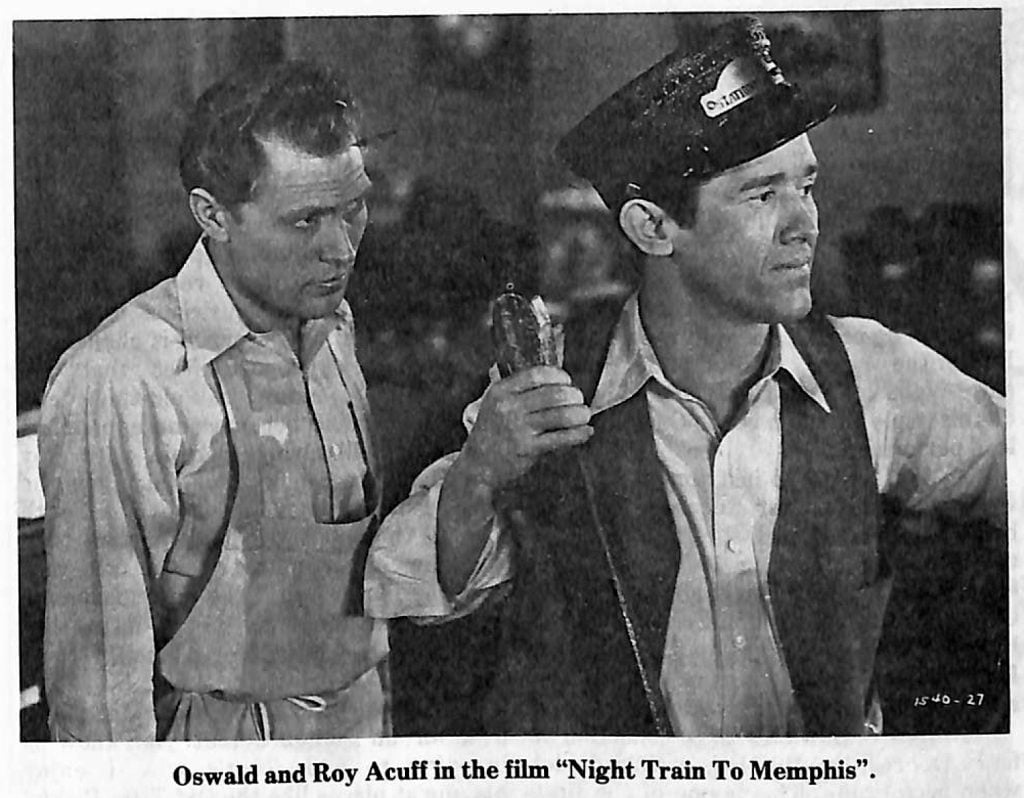
Through the years, Oswald has performed on many albums with Roy Acuff and the Smoky Mountain Boys, but in 1961 he cut his first solo album for Starday. Back up musicians included Cowboy Copas on guitar, Jimmy Riddle on harmonica, Howdy Forrester on fiddle and Junior Husky on the bass. Oswald did some vocals as well as performing on both banjo and Dobro. The result: a fine album which, unfortunately is no longer available.
Oswald is very proud to be on the Nitty Gritty Dirt Band’s “Circle” album for which he received a gold record. “The End of the World”, “Sailin’ on to Hawaii” and “Wabash Cannonball” are the songs on this triple album in which Oswald is the lead performer.
In 1971, a Dobro instrumental album was cut with Rounder Records, followed by an album of vocal, Dobro and banjo on the Tennessee label in 1974. And now Oswald and Charlie’s latest album, “That’s Country”, was released in February, 1975 by Rounder Records. Norman Blake, Sam Bush and Joe Zinkan guest on this variety album of old-time bluegrass music.
In spite of Oswald’s large collection of fancy Dobros, he still plays a 1928 model when performing. This is one of the first instruments made by the Dopera Brothers, and to Oswald, it’s sound is superior to the other fancier models he owns. “My original Dobro when I started with Roy was a 1929 model. Sometime along in the late 1940’s when we was down in Florida, it got stolen out of my car. It was a fine instrument and that really made me sick.”
Several years ago, Mr. Dopera presented Oswald with a beautiful, engraved Dobro on the Grand Ole Opry. George Chestnut, a Dobro distributor from Florida had arranged for the presentation. That instrument now hangs in Roy Acuff s exhibit in Opryland.
Enjoying for years recognition and acclaim that most musicians can only dream of attaining, Oswald is challenged by the great opportunities that are continually opening as old-time and bluegrass music becomes more popular. While he will always remain with Roy Acuff and the Smoky Mountain Boys, he also enjoys developing his own act with Charlie Collins. But more important than the new opportunities is the fact that creating music is still the basic challenge and satisfaction in his life. Whether the audience is large or small, their appreciation is gratifying.
“It is very satisfying to sit down and pick for an audience that you know is listening to you. That’s why I enjoy playing at places like the Old Time Pickin’ Parlor in Nashville. There, most people come for serious listening. On a big show or on the radio, you don’t know if the people are listening or not. But you go down to a nice club to play and everyone is so quiet you could hear a pin drop nearly all over the house. You know they are listenin’ to you then, and it’s a real thrill!”
